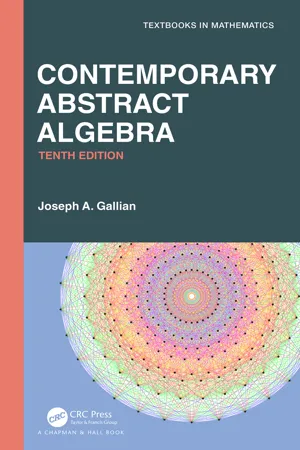
Contemporary Abstract Algebra
- 635 pages
- English
- ePUB (mobile friendly)
- Available on iOS & Android
Contemporary Abstract Algebra
About this book
Contemporary Abstract Algebra, Tenth Edition
For more than three decades, this classic text has been widely appreciated by instructors and students alike. The book offers an enjoyable read and conveys and develops enthusiasm for the beauty of the topics presented. It is comprehensive, lively, and engaging.
The author presents the concepts and methodologies of contemporary abstract algebra as used by working mathematicians, computer scientists, physicists, and chemists. Students will learn how to do computations and to write proofs. A unique feature of the book are exercises that build the skill of generalizing, a skill that students should develop but rarely do. Applications are included to illustrate the utility of the abstract concepts.
Examples and exercises are the heart of the book. Examples elucidate the definitions, theorems, and proof techniques; exercises facilitate understanding, provide insight, and develop the ability to do proofs. The exercises often foreshadow definitions, concepts, and theorems to come.
Changes for the tenth edition include new exercises, new examples, new quotes, and a freshening of the discussion portions. The hallmark features of previous editions of the book are enhanced in this edition. These include:
- A good mixture of approximately 1900 computational and theoretical exercises, including computer exercises, that synthesize concepts from multiple chapters
- Approximately 300 worked-out examples from routine computations to the challenging
- Many applications from scientific and computing fields and everyday life
- Historical notes and biographies that spotlight people and events
- Motivational and humorous quotations
- Numerous connections to number theory and geometry
While many partial solutions and sketches for the odd-numbered exercises appear in the book, an Instructor's Solutions Manual written by the author has comprehensive solutions for all exercises and some alternative solutions to develop a critical thought and deeper understanding. It is available from CRC Press only. The Student Solution Manual has comprehensive solutions for all odd-numbered exercises and many even-numbered exercises.
Frequently asked questions
- Essential is ideal for learners and professionals who enjoy exploring a wide range of subjects. Access the Essential Library with 800,000+ trusted titles and best-sellers across business, personal growth, and the humanities. Includes unlimited reading time and Standard Read Aloud voice.
- Complete: Perfect for advanced learners and researchers needing full, unrestricted access. Unlock 1.4M+ books across hundreds of subjects, including academic and specialized titles. The Complete Plan also includes advanced features like Premium Read Aloud and Research Assistant.
Please note we cannot support devices running on iOS 13 and Android 7 or earlier. Learn more about using the app.
Information
1
Introduction to Groups
Symmetries of a Square



Table of contents
- Cover Page
- Half-Title Page
- Series Page
- Title Page
- Copyright Page
- Dedication Page
- Contents
- Notations
- Preface
- 0 Preliminaries
- 1 Introduction to Groups
- 2 Groups
- 3 Finite Groups; Subgroups
- 4 Cyclic Groups
- 5 Permutation Groups
- 6 Isomorphisms
- 7 Cosets and Lagrange's Theorem
- 8 External Direct Products
- 9 Normal Subgroups and Factor Groups
- 10 Group Homomorphisms
- 11 Fundamental Theorem of Finite Abelian Groups
- 12 Introduction to Rings
- 13 Integral Domains
- 14 Ideals and Factor Rings
- 15 Ring Homomorphisms
- 16 Polynomial Rings
- 17 Factorization of Polynomials
- 18 Divisibility in Integral Domains
- 19 Extension Fields
- 20 Algebraic Extensions
- 21 Finite Fields
- 22 Geometric Constructions
- 23 Sylow Theorems
- 24 Finite Simple Groups
- 25 Generators and Relations
- 26 Symmetry Groups
- 27 Symmetry and Counting
- 28 Cayley Digraphs of Groups
- 29 Introduction to Algebraic Coding Theory
- 30 An Introduction to Galois Theory
- 31 Cyclotomic Extensions
- Selected Answers
- Index